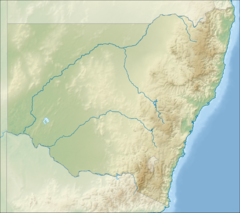Green Cape Lighthouse

Green Cape Lighthouse
|
|
|
New South Wales
|
|
| Location |
Green Cape New South Wales Australia |
|---|---|
| Coordinates | 37°15′41.01″S 150°2′57.58″E / 37.2613917°S 150.0493278°ECoordinates: 37°15′41.01″S 150°2′57.58″E / 37.2613917°S 150.0493278°E |
| Year first lit | 1883 |
| Deactivated | 1992 |
| Construction | concrete tower |
| Tower shape | square frusrum base with octagonal prism tower with balcony and lantern |
| Markings / pattern | white tower, black balcony |
| Height | 29 metres (95 ft) |
| Focal height | 44 metres (144 ft) |
| Original lens | 1st order Fresnel lens |
| Light source | mains power |
| Intensity | 1,000,000 cd |
| Range | 40 kilometres (25 mi) |
| Characteristic | Fl (2) W 10s. |
| Admiralty number | K2570 |
| NGA number | 6588 |
| ARLHS number | AUS-085 |
| Managing agent | Australian Maritime Safety Authority |

Green Cape Light. The current light is the skeletal tower to the right of the original tower.
|
|
| Location | Green Cape, New South Wales, Australia |
|---|---|
| Year first constructed | 1992 |
| Construction | metal skeletal tower |
| Tower shape | square pyramidal tower |
| Markings / pattern | white tower |
| Height | 49 feet (15 m) |
| Focal height | 118 feet (36 m) |
| Intensity | 37,500 cd |
| Range | 17 nautical miles (31 km; 20 mi) |
| Characteristic | Fl (2) W 15s. |
| Admiralty number | K2570 |
| NGA number | 6588 |
| ARLHS number | AUS-260 |
| Managing agent | NSW National Parks (Ben Boyd National Park) |
The Green Cape Lighthouse is a lighthouse located at the tip of Green Cape, a headland forming the northern boundary of Disaster Bay, in southern New South Wales, Australia. It is the southernmost lighthouse in New South Wales and Australia's first lighthouse built in concrete. At 29 metres (95 ft) it is also the second tallest lighthouse in New South Wales. It marks Green Cape on the northerly shore hugging sailing course.
The need for lighthouse was approved in 1873, following a series of wrecks on the southern shore. After rounding Cape Howe, northerly ships would hug the shore to avoid the East Australian Current. Green Cape was the first major projection they would encounter. Original tenders were for a stone lighthouse and rubble quarters. However, with the soft local sedimentary, no one tendered. In 1870 the specifications were changed to concrete and a budget of £17,000 AUD was set.
The tower was designed by James Barnet in 1880 and the contract was awarded to Albert Aspinall who quoted £12,936 in December 1880. The tender was for the concrete tower, two houses of double brick with cement render, and associated structures.
Aspinall first had to find a way to move the materials from Eden to the site. The nearest safe anchorage was in Bittangabee Bay, north along the coast from Green Cape, where he built his storeroom and jetty. He then spent five months building a 7 kilometres (4.3 mi) wooden tramway from Bittangabee Bay to the cape. Materials were transported to the site on wooden trolleys pulled by horses. This first phase was complete in June 1881, and Aspinall commenced the construction.
Major problems were encountered when the site was found to lie on a 6 metres (20 ft) white clay belt, forcing the foundation to be dug to 9 metres (30 ft). Work stopped in June 1883 due to financial difficulties, and Aspinall's creditors completed the project, which was lit on 1 November 1883.
The original apparatus, still mounted in the lantern, is a Chance Bros. 1st order revolving Fresnel lens dioptric. Its light characteristic was one flash every 50 seconds and it was visible to 19 nautical miles (35 km; 22 mi). The light source was a four-wick kerosene-burning lamp with an intensity of 100,000 cd.
...
Wikipedia

